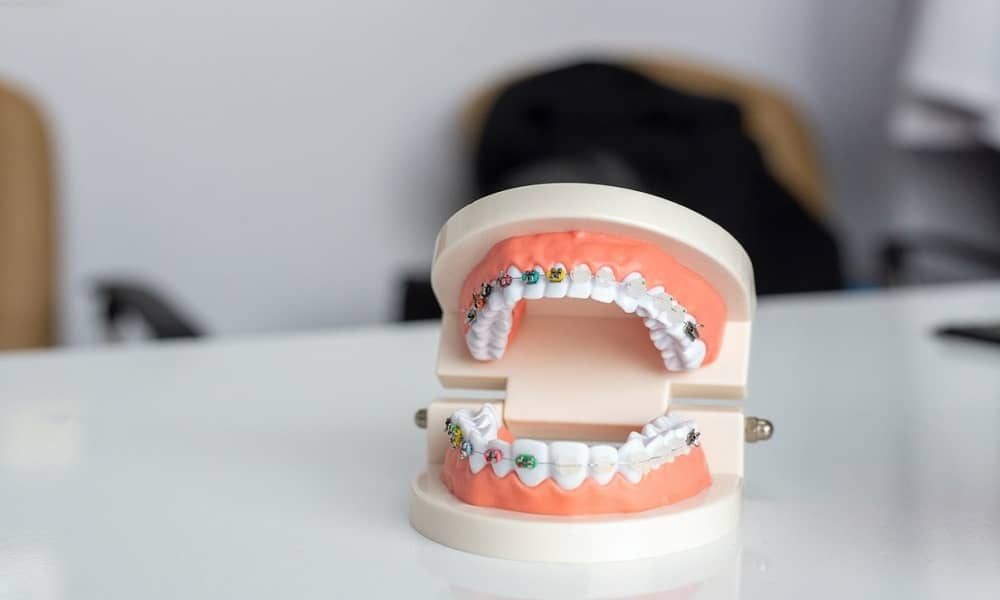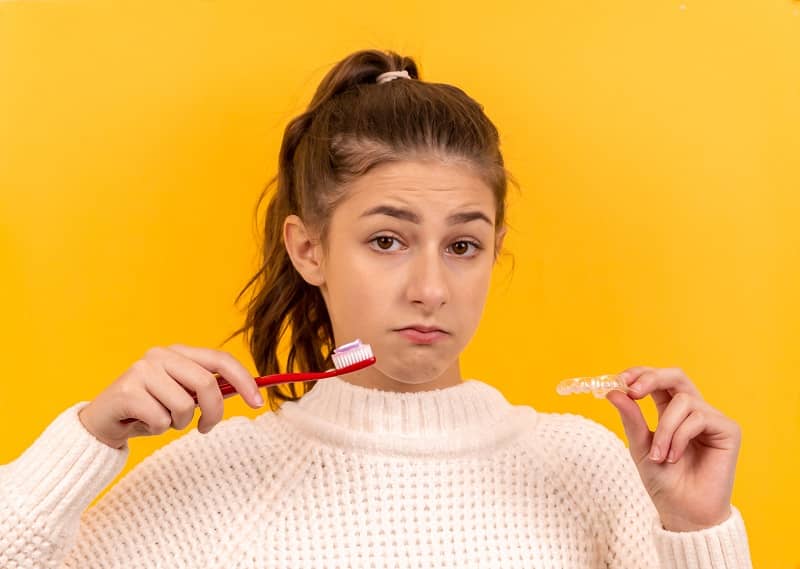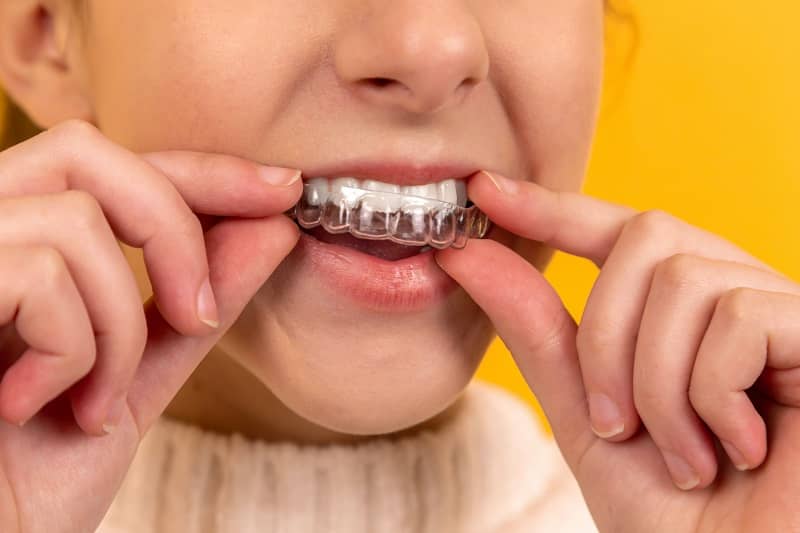
22 Oct Crooked Teeth and Misalignment: Causes, Health Risks & Treatments
Crowded or crooked teeth are not just aesthetic spoilers but affect health in ways way beyond your imagination.
There are many complications that can arise just as a result of ignoring a crooked tooth.
But the good news is you can dodge that by first being aware of what causes crowded teeth and then knowing how to remedy the issue.
Today’s blog will help you with that!
It covers all the causes of misaligned teeth and how you can treat the issue.
As a result, you get not only those good-looking pearly whites but also prevent long-term health complications that can arise as a result of poor oral health.
So, with that, let’s jump right in…
What Causes Crooked Teeth?
Misaligned, crowded, or crooked teeth are commonly seen among people of different ages.
Crooked teeth simply mean teeth that are twisted, rotated, angled, or just overlapped, causing crowding or other dental problems like misaligned teeth and jaws.
The common signs of teeth misalignment are usually evident in:
- Upper Jaw – Anterior teeth positioned higher with their pointing surface in outward directions.
- Lower Jaw – Anterior teeth in twisted directions.
Misalignment can be caused by several factors including the incorrect development and positioning of teeth.
The following section discusses what causes misaligned teeth, and, as a result, a misaligned bite.
6 Causes of Crooked Teeth

Common reasons behind crooked teeth can include:
- Size of the jaw
- Wrong oral habits
- Teeth misalignment
- Parental genetics
- Lack of oral/dental care
- Facial injuries or accidents
Both temporary and permanent dentition can erupt to be crooked or can become crooked due to certain factors.
Usually, temporary dentition erupts crooked only when a tooth is bigger than the gum space where it has to grow .
Apart from that, repetitive habits among babies can also push the teeth to grow out crooked.
However, it’s not necessary that your child’s crooked primary dentition paves way for the permanent teeth growing in crooked.
Permanent dentition is only affected by the issues of temporary dentition in two conditions:
- The temporary teeth were crowded – In such cases, even permanent dentition can turn out to be crowded.
- Premature falling of temporary dentition – In this case, permanent dentition may erupt in a slanting direction.
Other 6 factors that can affect the direction of dentition and cause crooked teeth are:
#1. Jaw Size
Different people have different jaw sizes. People with smaller jaws are often prone to crowding or misaligned teeth as there’s not enough space for teeth to grow into.
#2. Myofunctional Habits (Wrong Oral Behaviors)
Myofunctional habits are repetitive habits that exert pressure on the muscles and affect the normal functioning of the mouth.
Some of these habits can be present since childhood:
- Thumb Sucking – Vigorous thumb sucking exerts constant pressure on the teeth and the palate that can cause many long-term issues like an overbite (where the upper jaw protrudes outward), misalignment of teeth, misaligned jaw, and sensitive hard palate.
- Use of Pacifier – Children above the age of 4 who have the constant habit of using pacifiers can invite many oral issues that include misalignment of teeth.
- Tongue Thrusting – It is a condition where the tongue exerts pressure on various distant parts of the oral cavity.
NOTE: This can be a common cause of crooked teeth as when pressure is exerted on the back of any tooth, the tooth can move forward in a direction.
- Mouth Breathing – The habit of breathing through the oral passage among kids can lead to misaligned teeth.
#3. Occlusal Misalignment
The chronological eruption works in a way that the upper teeth fit slightly over the lower teeth. The teeth have grooves that fit in the cusp of other teeth.
For example, the maxillary molars (upper molars) fit in 1/3rd of the grooves of mandibular molars (lower molars).
However, when the right alignment is disrupted, the occlusion becomes altered leading to either overbite or underbite.
In the case of an overbite, the anterior maxillary teeth move outwards. Whereas, in underbite, the mandibular teeth (lower arch) protrude outward farther than the maxillary teeth (upper arch).
#4. Genetics
Children with parents who have crooked teeth are more likely to have crooked teeth.
In fact, children can be at greater risk if they also have the habit of thumb sucking or mouth breathing in addition to parental genetics.
As a result, paying attention to their oral health and any misalignment issues that might arise is absolutely imperative for these children.
#5. Poor Oral Care
Different types of dental problems that go unnoticed can lead to misaligned teeth.
For example, an untreated cavity can be what makes your teeth crooked as it affects the adjacent teeth’ eruption.
#6. Facial Injury
Facial blows or injuries can cause one or more teeth to be twisted.
For instance, if you ever have an accident, you can expect your teeth to get affected severely if there’s a huge blow to the face.
Many people don’t pay much heed to their misaligned teeth thinking that it’s just a matter of aesthetics.
But according to health experts, misaligned teeth are not just unhealthy for your oral cavity but also for your overall body.
Here’s how crooked teeth can cause some major complications.
Can Crooked Teeth Affect Your Health? [Risks Involved]

YES!!
Crooked teeth can definitely be the cause behind some health risks, depending on the type and severity of the misalignment.
Health experts believe that severe misalignment can cause problems in eating, drinking, speaking, and even breathing.
Often crooked teeth can dig deeper into the gums or grow so outward that they dig into the lips causing pain.
They can further lead to tooth decay and can even lead to painful jaws.
Some other complications and health risks of crooked teeth include:
#1. Gum Diseases
Perhaps, gum issues are the most common among the health risks of crooked teeth.
Crooked teeth make it difficult to keep your gums and oral cavity clean leading to many gum diseases.
As plaque develops between misaligned teeth, it offers a sustainable environment to bacteria further causing the bacterial colonies to grow.
With crowded teeth, it is not easy to clean between every tooth and that easily leads to an increase in plaque formation.
ALSO READ: Ways to Treat Gingivitis | [6] Home Remedies & Dental Treatments
#2. Teeth Wear Out Faster
On the off chance your mandibular teeth are crooked, they would protrude and rub against the maxillary teeth.
This could lead to rapid wearing out of the enamel leading to many health issues like sensitivity.
There are also chances of the development of caries and tooth abscesses.
#3. Chewing Becomes Difficult
Misalignment of teeth can lead to misaligned jaws and can cause:
- Overbite
- Underbite
- Open bite
All these lead to malocclusion which makes chewing difficult. This can further cause digestive problems.
#4. Bad Breath
Crooked and crowded teeth are a breeding ground for bacteria to thrive in, increasing the issues of bad breath.
Although you can fight this by using mouthwashes, that would still be a temporary solution.
Crooked teeth treatment is what you should go for to eradicate the problem from its root.
#5. Psychological Effects
Aesthetics are important for your psychological confidence. A crooked smile can cause a rise in your anxiety and stress levels.
Anything that affects your confidence and mental peace can be harmful to your mental health.
#6. Heart Problems
Now, this is something usually nobody thinks of. But oral health and cardiovascular health are related.
Though this is still under investigation, we can’t risk not considering it.
#7. Higher Chances of a Fractured Tooth
Crooked teeth exert a lot of pressure on adjacent teeth, jaw, and even jaw muscles.
Strained jaw muscles due to crooked teeth cause excess strain on the teeth and can be painful.
But what’s more concerning is the fact that too much pressure can also lead to your teeth breaking off.
#8. Headaches
Pain in jaw muscles or strain on teeth due to constant rubbing can radiate towards the head and cause severe headaches.
Any part of the muscles of the face when under pressure radiates pain towards the head causing headaches.
#9. Temporo-Mandibular Joint Disorder
TMJ is basically the joint that regulates the movement of your upper and lower jaw.
However, misalignment of the teeth or the jaw can lead to TMJ disorder.
Unfortunately, the disorder has many painful symptoms, such as pain around your neck, shoulders, and head.
It is mainly caused because of wear and tear of the jaw.
So, looking at all such complications, you would definitely want to google right away, “how to fix crooked teeth in adults”.
Good for you, the treatment is not hard to get.
In fact, there’s a range of options to fix teeth and jaw misalignment. However, most of these treatments that work would require you to be a little patient.
How to Fix Crooked Teeth?

Choice of treatment depends on the severity of the misalignment.
Regardless, the most popular and used solution is to fix crooked teeth with braces or Invisalign.
Treatment of Crooked Teeth
There are multiple treatment options when you go to a dentist. And most of these methods can give you guaranteed results.
#1. Braces
There are different types of braces available to help you with the treatment:
- Metal Braces – They are relatively bulkier as compared to other braces as they contain wire and brackets. Sometimes, these might also cause irritation and discomfort. Still, metal braces are the strongest and most effective way of straightening your teeth.
- Ceramic Braces – They are similar to metals but have colors that match the color of your teeth. Since they appear to be invisible, ceramic braces are the most popular choice among people. However, note that it may also cost you slightly more than the metal ones.
- Invisalign – These are a bit expensive but very comfortable to wear. Invisalign can be removed when eating or brushing, unlike other braces. They are clear plastic trays and don’t bond to your teeth. Invisalign helps to shift the teeth in small increments.
#2. Retainer to Straighten Teeth
There are two types of retainers – removable and fixed.
They are cheaper as compared to the braces, and you don’t need to visit the dentist as much as when you get braces installed.
#3. Veneers
They are used when the teeth are not severely crooked or crowded. Usually, they are composite or porcelain covers worn on the front of your tooth.
Needless to say, it’s more of an aesthetic option as it doesn’t straighten your teeth rather just makes them look straight.
#4. Teeth Straightening Surgery – Faster Alternative to Braces
Surgeries make your time with braces short. These surgeries are usually minor ones where the dentist repositions the bone and gums holding your teeth in place.
But there are also major surgeries that realign your jaw. The treatment depends on how complex your case is. The final choice, of course, rests in your hand.
Do not try to straighten your teeth on your own without the supervision of a dentist or orthodontist. The main reason for this is the clinical assessment of your bite and teeth misalignment, which can only be done properly when you visit a professional. Usually, treatment of crooked teeth may also include taking an X-Ray and assessing the health of your gums and dental bone. Furthermore, trying to fix your crooked teeth on your own can lead to complications including severe pain, cuts, and weakened teeth. Too much pressure on your jaws and teeth, as a result of using home remedies for crooked teeth, can also affect the tooth root and the ligaments that keep your teeth firmly in place.Can You Fix Crooked Teeth at Home?
On the off chance, you are still doubtful about whether you should go for the treatment, here are some of the benefits of getting your crooked teeth straightened.
Benefits of Fixing Crooked Teeth
These are the main benefits of getting your teeth straightened:
- The gums fit securely around the teeth preventing periodontal disorders.
- It becomes easier to clean your teeth and keep out infection-causing bacteria.
- No excess wear and tear of teeth.
- Fewer chances of damage to teeth caused due to misaligned jaws.
- No excess pressure on the gums, jaw, and muscles reduces the chances of sudden oral cavity pain.
- Better aesthetics.
With this, we’ve reached the end of this blog. Right below is a short summary of the above discussion.
The Takeaway Message
Correcting crooked teeth is not only about fixing your looks. Rather, take it as a matter of long-term oral health.
Whether your teeth are twisted or your jaw doesn’t sit quite right, there are effective treatments to correct dental issues.
The only critical problem you might face is the cost as dental treatments are usually expensive. This can become an issue, especially when you don’t have insurance.
However, costs also vary and depend on the kind of treatment you get. In the end, though, investing is worth it for your health and well-being.
Before leaving you with final words, we again emphasize that there’s no home remedy that can treat your misalignment within a week!
Even if someone answers how to get straight teeth in 2 weeks at home naturally, there’s a likely chance that it’s the wrong advice.
The best way to straighten your teeth is by visiting your dentist or an orthodontist.
It’s always in the hands of a professional to give your aesthetics a final touch.
Hence, instead of googling remedies, book an appointment with your dentist as soon as possible for early treatment.
There are many painless and comfortable methods to get back your joy; patience is all it takes.
Now, we hope this blog addresses your concerns. For more on dental health and crooked teeth treatment, ask your questions in the comments section down below.



No Comments